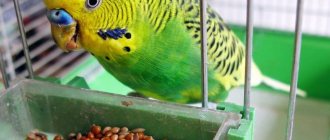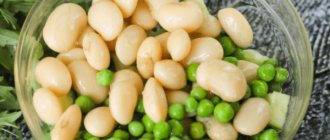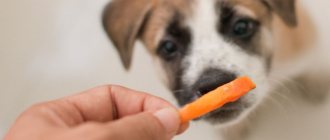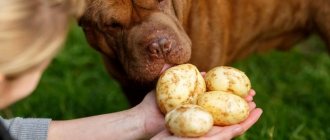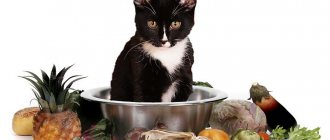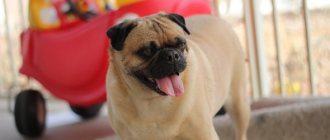Budgerigars are the leaders in the number of households. When a pet appears in a home, it brings a lot of joy and pleasure to its owners. And as a sign of gratitude, the owner surrounds the parrot with care, attention and affection, pampering the pet with all kinds of delicacies. Pays considerable attention to nutrition, which, in addition to everything else, plays an important role in the life of a bird.
The pet is not picky about food. In addition to grain mixtures, his menu should be diluted with fruits and vegetables. Fruits and roots contain a huge amount of essential vitamins and minerals that are involved in the development, growth and health of birds.
Fruit menu
Introduce fresh, dried and dried fruits into your parrot's menu. But keep in mind that it is better to make the preparations yourself. When eaten, the bird will not only receive pleasure, but also the necessary content of vitamins and minerals that are necessary daily for the good functioning of the body. Each fruit contains a different amount of useful components. When feeding fruit treats, follow the norm.
Many owners ask various questions: can budgies eat tangerines or kiwis, and what fruits to feed and which not. Let's begin to clarify these issues.
We recommend reading: How much does a budgie cost?
Here are the fruits you can give your budgies:
- Bananas are very nutritious, rich in calcium, magnesium and potassium. Content of fiber, all kinds of useful acids. A couple of pieces a day will be enough to maintain and saturate the body with essential vitamins;
- Apple is a vitamin cocktail, enzymes that are good for the digestive tract. Contains tannins, plant fibers and organic acids. The norm need not be limited;
- pomegranate is very necessary, its substances ensure the functioning of the cardiovascular system. A few grains a day, but introduce them gradually, starting with a minimum amount. The norm per day is no more than 1/6 part;
- kiwi – strengthens the parrot’s immunity. The fruits are leaders in vitamin C content. Protects the body from viruses;
- pears - for digestion, which is promoted by pectin. The composition contains carbohydrates, iron, phosphorus. Peel the skin first. Give in any quantity;
- orange – contains fiber, essential oils, carbohydrates. Well protects the body from viral and infectious diseases. A small piece a day. Also add other citrus fruits to the menu. Dilute lemon juice with water;
- grapes are rich in microelements and vitamins. Give 2 - 3 berries without skin, there is no need to remove the seeds. Cleanses the body and removes toxins;
- pineapple - the composition has a positive effect on muscle tissue and strengthens blood vessels. Has general strengthening properties. Destroys proteins, helps digest and absorb protein foods.
- apricot is the owner of sugar, inulin, starch, provitamin A, iron, acid. Supports the immune system, prevents cardiovascular diseases;
Persimmon, mango, papaya, avocado - these exotic fruits are not recommended to be given to your pet.
Important! Add a variety of edible berries, fresh or frozen, to your diet. You can prepare it yourself in the summer. The treat must be fresh and well washed, otherwise it will lead to serious illness and death.
All fruits should be peeled and cut into pieces. Remove the seeds, which are dangerous because they contain hydrocyanic acid. It is recommended to feed with vitamins from your garden, so-called natural products. Store-bought fruits often contain an abundance of nitrates and other substances that are detrimental to the health of the parrot.
We recommend reading: How to tame your budgerigar to your hands
Benefits and harms
The culture is primarily a rich source of vitamins: A, C, E, PP, as well as group B (1, 2, 5, 6). A set of useful elements helps improve the functioning of the gastrointestinal tract and strengthen the immune system.
Pumpkin contains a significant proportion of minerals :
- phosphorus;
- calcium;
- iron;
- magnesium and others.
Due to its low calorie content and high fiber content, the product is used as an additional tool in the treatment of obesity.
Pumpkin quickly saturates the animal’s body, maintaining a feeling of fullness for a long time, and the potassium included in the culture helps get rid of excess fluid.
The product has a high content of carotenes : about 5 times more than in carrots. Transforming into vitamin A, the element helps improve vision, plus it acts as a powerful antioxidant, protecting the animal’s body from free radicals.
Pumpkin contains a lot of vitamins C, which are involved in the production of serotonin. It in turn helps strengthen the immune system. Therefore, consumption of the crop is especially important in winter and during the molting period, when the pet’s body is weakened.
Pumpkin seeds are used as a prophylactic against parasites. The anthelmintic properties of the culture will come in handy if, in addition to birds, there are other pets in the house that have access to the street.
But in some cases, the vegetable can be harmful. If your parrot has problems with the kidneys or stomach, including increased acidity, then it is better to avoid pumpkin. The culture should also not be given to immature young animals that have not yet begun to feed on their own.
Exceeding the daily norm is fraught with bloating and loose stools. Some birds may experience individual intolerance to the product, manifested by an allergic reaction. Before including pumpkin in your pet’s diet, it is a good idea to consult with your breeder or veterinarian.
Vegetable menu
Fresh vegetables are an integral part of a budgie's diet. Give what you need every day.
Let us explain what vegetables can be given to a budgie:
- cabbage - white cabbage, broccoli, Peking cabbage and other types of this family. Everything contains a lot of all kinds of useful components. It is beneficial for the stomach when consumed, stimulates metabolism and easily cleanses the body of waste and toxins;
- carrots – the root vegetable contains carotene, lysine, ascorbic and pantothenic acid. Promotes pet growth and good vision. One piece a day is enough;
- pumpkin - in addition to its aesthetic qualities, has many useful components. The pulp is saturated with all kinds of vitamins, magnesium, potassium, iron. Removes toxins and excess cholesterol;
- cucumber – a huge content of vitamin E. A rich community of minerals. Helps in the absorption of food and normalize metabolism;
- beets - occupies a leading position in the presence of useful components. It has antioxidants and many other useful minerals necessary for the life of a budgie. Provides a wide range of benefits to improve the functioning of the body.
- Tomato or tomato has obvious benefits for your pet; it is a powerful antioxidant. Is a source for the health of the parrot. Normalizes metabolism, prevents the appearance of fungal diseases.
How to give cabbage to a parrot
Cabbage is given to the bird daily as an addition to the main menu, i.e. three times a day. It should be given in small quantities and always in crushed form. Regular (white cabbage) is introduced into the diet fresh or after treatment with boiling water to make it softer.
You can give both leaves and stalks. It is advisable to grate it. Beijing, cauliflower and kohlrabi must be blanched (immerse in boiling water for 2 minutes and rinse with cold water). Broccoli also needs to be treated with boiling water.
Vegetables must be given to the bird, since it cannot get all the necessary substances from grain feed. White cabbage is the best source of nutrients.
What not to give to a budgie
The budgie is quite inquisitive and often shows interest in everything you eat.
Important! You cannot feed your pet from the table. Human food can harm birds.
There is no need to add various nuts and seeds to your diet. They are fatty and often difficult to digest, leading to indigestion. When feeding your pet fruits and vegetables, follow the norm. The main thing is to know which of them can worsen your health. There are individual intolerances of the body that cause disorders, pay attention to this. Immediately exclude such bait from your pet’s menu. There are also vegetables that contain a high content of essential oils, corned beef and other non-useful substances. They are harmful to the parrot and lead to poisoning and death:
- raw potatoes;
- radish;
- green onion or tuber;
- garlic;
- celery;
- radish;
- eggplant.
There are also greens that should not be given:
- parsley;
- dill;
- cilantro.
But there is no need to completely limit greens. Feed with young leaves from fruit trees. Sprouted leaves of wheat or oats. Lettuce leaves, clover.
If you have doubts about giving or not giving, then give preference to what you know. Experimenting with food is not recommended.
We recommend reading: How to breed budgies at home
Forbidden vegetables
Vegetables prohibited for parrots include the following:
- Onions and garlic contain essential oils that are harmful to birds. Celery and various herbs are dangerous for the same reasons. They can cause pulmonary failure.
- Radishes are harmful to parrots due to their pungency and bitter taste.
- Potatoes and eggplants are dangerous due to their high content of the toxic compound solanine.
How to train a parrot to eat vegetables and fruits
Sometimes you encounter that a parrot does not show any interest in additional food. But you shouldn’t despair; with some effort and some tricks, you can overcome the problem. Try to arouse your pet's interest in additional food. You can arrange it in the form of a garland, stringing assorted vitamins in order. Grate and serve as a puree. Eat in front of him and hand feed him. You show all sorts of tricks and tricks. Be patient, and the result will appear soon. Keep in mind that perhaps the parrot will not eat everything, but will choose something that suits its taste preferences.
As for pumpkin and cabbage
Given the conditions of home maintenance and the availability of real vitamins, which in our time are quite expensive, it is worth discussing two fruits that are easiest to get in the winter. You can’t call them expensive either: pumpkin and cabbage.
Can budgies eat cabbage? It depends on what variety. If it comes to white cabbage, then it’s quite suitable. It will become the basis for replenishing microelements and vitamins. Cabbage is very rich in them. Give finely chopped and in small portions. It contains fiber. And this is important for a parrot. It is better not to give Chinese cabbage or cauliflower. These types of food will not bring any benefit to the bird.
What to look for when choosing vegetables and fruits
When choosing an assortment of vitamins for your budgerigar, focus on the appearance of the fruits and root vegetables. They should not raise suspicions about quality. Choose fruits and vegetables that are ripe, fresh, and free from mold and rot. Don’t try to experiment with nutrition, just give what you know. If possible, feed only seasonal fruits.
The main diet of a budgerigar is a grain mixture, but a vegetable and fruit menu is also important in the pet’s diet. To maintain health, vitamins and minerals play an important and major role. When eating a variety of food, the parrot’s body receives all kinds of components that saturate the body with all the necessary nutrients.
Follow the rules and regulations for feeding your pet. In return, you get a healthy, active and good-humored parrot that will delight you for many years of life. If you liked the article or have something to add, leave your comments and also join our VKontakte group.
Taming domesticated parrots to eat fruit
It just so happens that the majority of birds purchased by hand are bought from various resellers, who often do not feed the parrots anything special. Such parrots, during their stay with resellers, consume the cheapest grain mixtures, getting used to them and not wanting anything else.
However, as you probably already understood from the previous section, such cheap grain formulations cannot contain all the vitamins and minerals that pets need.
Therefore, in order to accustom their budgies to eat not only grain mixtures, but also fruits, some owners have to resort to various tricks. We will now describe some of them in detail.
Firstly, while in front of your pet’s cage, eat or imitate the process of eating the treats offered to the parrot. Wavy animals very often imitate their owners, trying to imitate them in everything. Therefore, your behavior will probably be enough for them to start eating the fruits offered to them.
Secondly, you can easily diversify the process of eating berries and fruits by turning it into a game. Pet stores sell many clever devices designed to hold food in them. In these cases, your bird will periodically eat the food offered to it during the game.
Thirdly, you can often make juice from the treats offered to birds. Parrots will certainly happily drink freshly squeezed juices. Moreover, the vitamins in the juice are absorbed much faster and better by the bird’s body.
Greens in the diet
Greens must be present in the diet, no less than vegetables or fruits.
Make sure that your greens are thoroughly washed under running water. Like vegetables, greens should come from your own garden or rural ecological area, and in no case from the city.
- meadow grass
- burdock (burdock)
- branches of various thicknesses of fruit trees with buds, with young green leaves
- grapevine
- greens of cereal crops: oats, wheat, etc.
- woodlice
- carrot and beet tops
- knotweed
- leaf salads
- nettle leaves scalded with boiling water
- quinoa and spinach in limited quantities
- clover
- plantain leaves
What other vegetables can you give to wavy animals?
It is not advisable to feed your pet cabbage alone day after day. The parrot will simply get tired of it, and he may completely abandon it. It is more advisable to alternate cabbage with other equally useful crops.
Vegetables that are good for parrots:
- tomatoes;
- carrot;
- cucumber;
- pumpkin;
- beet;
- corn;
- green pea.
Some crops are contraindicated for birds:
- garlic;
- radish;
- celery;
- eggplant;
- potato.
Before including a new product in the daily diet, you should let your pet get to know it by treating it to a small piece, because some birds are allergic to certain components.
What to feed budgies
Ready grain mixture
Modern specialized stores have an impressive selection of ready-made mixtures. Choose one that says “food for budgies.” With the ready-made mixture, you do not need to worry about balancing your diet, because... the manufacturer did it for you. Ready-made foods contain all the necessary ingredients and vitamins, and some even have pieces of fruit added.
An example of a popular grain mixture is RIO food for budgies. It contains different varieties of millet, canary seed, flax seed, oats, wheat, hemp seed, Abyssinian nougat, calcium gluconate and algae.
You can also purchase Prestige food for budgies. Which is in demand among lovers of feathered pets. This food contains yellow, white and red millet, shelled oats, canary seed, flaxseed, oil noug, safflower.
These grain mixtures provide budgies with the necessary amount of proteins, carbohydrates and fats, as well as the necessary minerals.
Combined grain mixture
Compiling the mixture yourself is a responsible undertaking. Pay attention to the quality of the grain, do not buy from unverified places. High-quality grain is shiny and free of damage or mold. The grain mixture should be based on more than half millet or canary seed. Dilute the remaining portion with oats, flax, sunflower seeds or hemp seeds. Compound feed must contain at least three types of grain.
Porridge for parrots
If you are wondering what to feed your budgie if you run out of food, then the answer is porridge. If there is no food, cook buckwheat, oatmeal, pea, rice or wheat porridge for the parrot. Boil the porridge in water without sugar and salt, or simply steam it. Porridge also dilutes the diet.
Video What to feed a budgie. Feeding a budgerigar. How to feed a budgie
Water and juices
All birds must receive water. The amount depends on how much vegetables, fruits and food the birds eat, as well as on the temperature in the room. You may think that water for parrots does not require replacement every day, because your pet drinks very little. But that's not true. There should be fresh, clean water in your pet's cage every day. Moreover, in summer it is worth pouring fresh liquid into the drinking bowl 2 times a day.
Figuring out what kind of water to give parrots is not difficult. Just do not give your birds tap water, boiled water or carbonated water. It is best to give bottled water without gas, which contains potassium (at least 20), magnesium, and sodium. You can offer your parrot filtered liquid from the tap, but in this case you must constantly monitor the condition of the filter. You can add a little lemon juice, a decoction of chamomile or rose hips to the water.
Juices are also very useful for a parrot. They need to be made in a juicer from vegetables or fruits (from the approved list) or bought ready-made in jars intended for baby food. If you offer your parrot store-bought baby juices, make sure they are sugar-free. Juices can be diluted with water. Make sure that the juice does not sit in the drinker for too long; juices quickly deteriorate in the heat.

